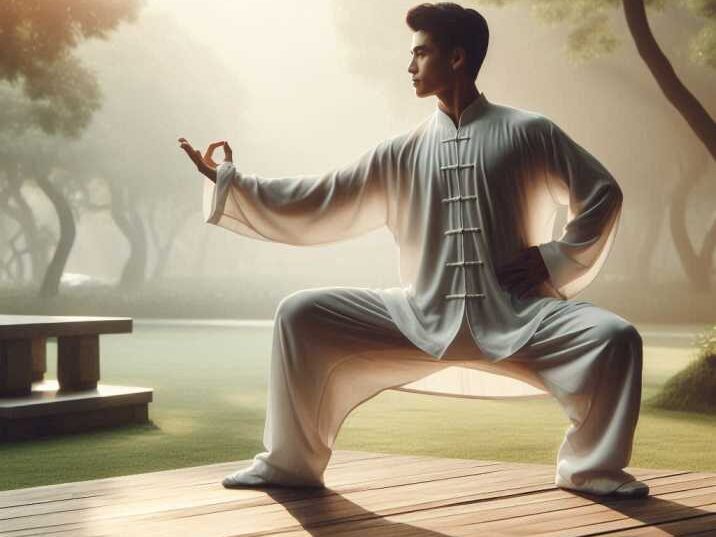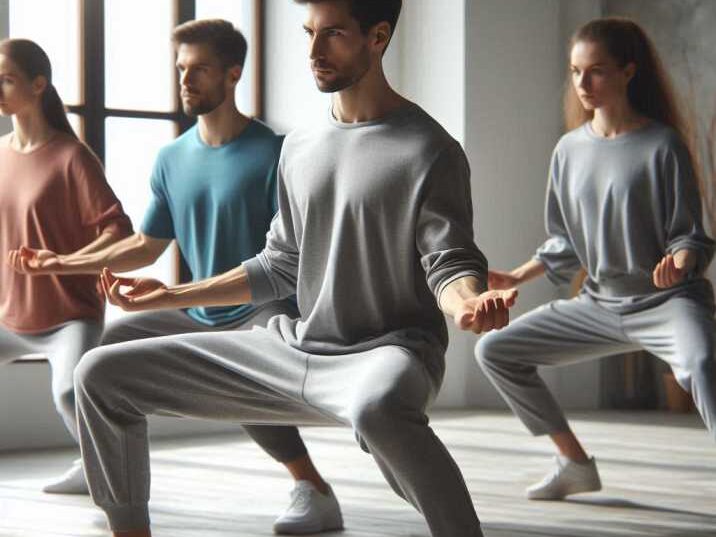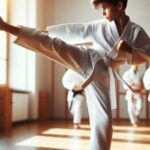Introduction
Table of Contents
Sitan Tai Chi & Martial Arts is a unique blend of ancient practices that focus on balance, strength, and inner peace. Tai Chi, also known as Tai Chi Chuan, is a Chinese martial art that combines slow, controlled movements with deep breathing. While it’s often viewed as a form of gentle exercise, Tai Chi is also a powerful martial art that teaches self-defense and enhances overall well-being. This article will take you through the fascinating world of Sitan Tai Chi and Martial Arts, explaining what it is, its benefits, and how it’s practiced. Whether you’re a beginner or someone interested in martial arts, this guide will provide valuable insights into this calming yet powerful discipline.

What is Sitan Tai Chi?
Tai Chi: The Art of Balance
Tai Chi is a traditional Chinese practice that emphasizes balance, coordination, and relaxation. It involves a series of slow, deliberate movements that are designed to improve both physical and mental well-being. Tai Chi is often referred to as “moving meditation” because of its gentle flow and focus on mindfulness.
Sitan Tai Chi: A Specialized Approach
Sitan Tai Chi, named after Master Sitan Chen, is a modern adaptation that incorporates both traditional Tai Chi and martial arts techniques. It’s a more structured and disciplined form of Tai Chi that combines the soft, flowing movements of Tai Chi with the more dynamic aspects of martial arts. This combination makes it suitable for self-defense, fitness, and stress relief.
The Benefits of Practicing Sitan Tai Chi
1. Enhances Physical Health
Sitan Tai Chi improves flexibility, strength, and coordination. It’s especially beneficial for improving balance, which can prevent falls and injuries. Regular practice can also enhance cardiovascular health, muscle strength, and joint mobility.
2. Reduces Stress and Anxiety
One of the key benefits of Sitan Tai Chi is its ability to reduce stress and anxiety. The slow, mindful movements combined with deep breathing help calm the mind and promote relaxation. It’s an excellent practice for those looking to manage stress in their daily lives.
3. Improves Mental Focus
Practicing Sitan Tai Chi requires concentration and mental focus. This can improve cognitive function and help you stay sharp and alert. It’s a great way to enhance mind-body connection.
4. Provides Self-Defense Skills
While Tai Chi is often seen as a gentle practice, Sitan Tai Chi also includes elements of self-defense. The martial arts techniques integrated into the practice teach you how to defend yourself in real-life situations.
5. Promotes Longevity and Well-being
Incorporating Sitan Tai Chi into your daily routine can lead to long-term health benefits. It’s known to promote longevity and overall well-being by keeping the body active and the mind at ease.
Sitan Tai Chi vs. Traditional Martial Arts
Tai Chi vs. Karate
While Tai Chi focuses on slow, fluid movements, martial arts like Karate emphasize speed, strength, and agility. Tai Chi is more meditative, whereas Karate is more aggressive and competitive. However, both practices build discipline and improve physical health.
Tai Chi vs. Kung Fu
Kung Fu is another Chinese martial art that involves a variety of techniques, including strikes, kicks, and grappling. Sitan Tai Chi, on the other hand, focuses more on balance and internal energy. While Kung Fu is intense and demanding, Tai Chi is gentler and more focused on inner peace.
Key Components of Sitan Tai Chi
1. Stances and Postures
In Sitan Tai Chi, stances and postures are the building blocks of every movement. Each stance is designed to help you maintain balance, strength, and proper alignment in your body. For example, the bow stance involves stepping one foot forward while keeping the other foot anchored behind you, distributing your weight evenly. The horse stance requires you to spread your feet wide apart and bend your knees, resembling a rider on a horse. These stances not only improve your physical stability but also help you connect your mind and body, making each movement purposeful and precise. The flow from one stance to another is smooth and continuous, helping to cultivate balance and coordination.
2. Breathing Techniques
Breathing is a crucial element of Sitan Tai Chi. Deep, controlled breaths are synchronized with each movement, creating a harmonious connection between your breath and body. This breath control enhances the flow of energy, or Qi, throughout your body, helping to calm your mind and reduce stress. By focusing on slow, deep inhalations and exhalations, you can develop a sense of inner peace and relaxation. This breathing technique is not only beneficial for your mental well-being but also helps improve your lung capacity and overall health.
3. Meditation and Mindfulness
Meditation and mindfulness are core components of Sitan Tai Chi, setting it apart from many other martial arts. As you practice, you focus on the present moment, letting go of distractions and worries. This state of mindful awareness allows you to achieve a sense of calm and clarity, which is essential for both mental and physical well-being. By incorporating meditation into your Tai Chi practice, you can improve your concentration, reduce anxiety, and cultivate a peaceful mindset. This mindfulness aspect also enhances your ability to perform movements with greater intention and awareness.
4. Flowing Movements
The flowing movements in Sitan Tai Chi are designed to be smooth, continuous, and graceful. These movements reflect the flow of Qi (energy) within your body and are practiced slowly and deliberately. The goal is to move with control and awareness, allowing you to feel the energy circulating through your body. Each movement transitions seamlessly into the next, creating a fluid sequence that promotes relaxation and balance. Practicing these flowing movements not only improves your physical coordination but also helps you develop a deeper connection with your inner energy.
How to Start Practicing Sitan Tai Chi
1. Finding a Class
Starting with Sitan Tai Chi can be exciting, and finding the right class is a great first step. It’s important to look for a qualified instructor who has experience in both the physical movements and the philosophical aspects of Tai Chi. Many martial arts studios, community centers, and even some gyms offer Tai Chi classes. When choosing a class, pay attention to the style being taught—some classes may focus more on the health and relaxation aspects, while others may include more martial arts techniques. A good instructor will guide you through the correct postures, breathing exercises, and mental focus required for Sitan Tai Chi.
2. Practicing at Home
If attending a class isn’t an option, or if you prefer a more flexible schedule, practicing Sitan Tai Chi at home is a great alternative. There are numerous online resources, including tutorial videos and step-by-step guides, that can help you get started. Begin with the basics, such as simple stances and breathing exercises. These foundational skills are crucial before moving on to more complex movements. It’s important to create a calm and quiet space at home where you can focus without distractions. As you progress, you can gradually add more advanced techniques to your practice.
3. Consistency is Key
Like any martial art, consistency is crucial in Sitan Tai Chi. Regular practice helps you develop better balance, coordination, and inner focus. Even if you’re just starting out, dedicating 15-20 minutes a day to practice can lead to significant improvements over time. The key is to be patient with yourself and build a routine that fits into your daily life. Whether you’re practicing at home or attending a class, consistency will help you progress and experience the full benefits of Sitan Tai Chi.
Table of Information: Sitan Tai Chi vs. Traditional Martial Arts
| Aspect | Sitan Tai Chi | Traditional Martial Arts |
|---|---|---|
| Focus | Balance, relaxation, internal energy | Speed, strength, external techniques |
| Movements | Slow, flowing | Fast, dynamic |
| Primary Benefits | Stress reduction, flexibility, mindfulness | Self-defense, physical fitness |
| Training Environment | Calm, meditative | Intense, competitive |
| Suitable For | All ages, fitness levels | Typically younger, more athletic individuals |
Conclusion
Sitan Tai Chi & Martial Arts is more than just a physical exercise; it’s a journey toward better health, mindfulness, and inner peace. Whether you’re interested in improving your physical fitness, reducing stress, or learning self-defense, Sitan Tai Chi offers something for everyone. By incorporating the principles of Tai Chi into your daily life, you can experience a balance of mind, body, and spirit that leads to long-lasting well-being.

FAQs About Sitan Tai Chi & Martial Arts
1. Can Sitan Tai Chi help with weight loss?
Yes, practicing Sitan Tai Chi can help with weight loss by improving metabolism and promoting overall fitness, though it’s not as intense as other martial arts.
2. Is Sitan Tai Chi suitable for kids?
Absolutely! Sitan Tai Chi is suitable for people of all ages, including kids. It helps them improve focus, balance, and discipline.
3. How long does it take to master Sitan Tai Chi?
Mastering Sitan Tai Chi can take years, but beginners can start seeing benefits within a few weeks of consistent practice.
4. What should I wear for Sitan Tai Chi practice?
Comfortable, loose-fitting clothing is ideal for practicing Sitan Tai Chi. This allows for free movement and flexibility.
5. Can Sitan Tai Chi be practiced outdoors?
Yes, practicing Sitan Tai Chi outdoors is highly recommended. Natural surroundings can enhance the meditative and calming aspects of the practice.


